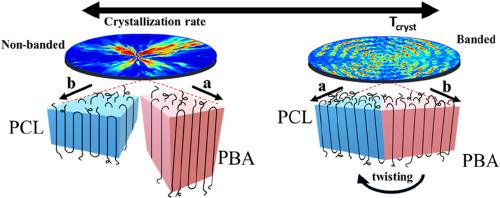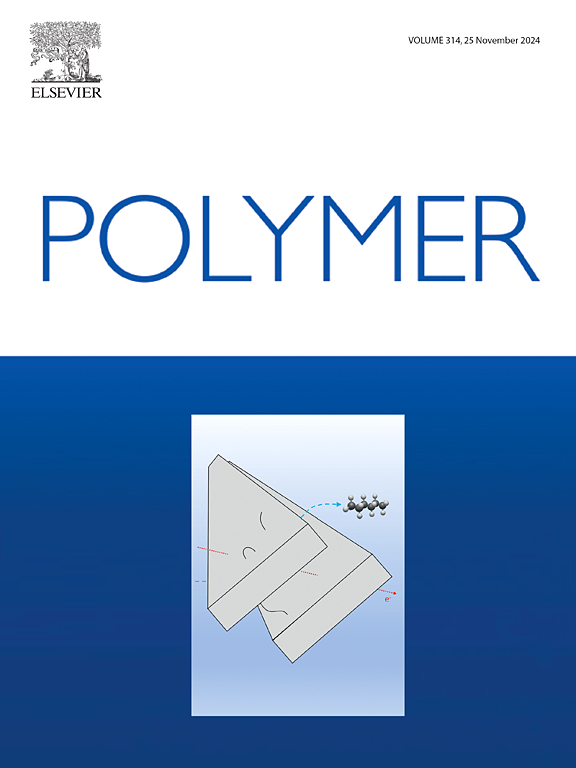Effect of Mutual Crystallization of Poly(butylene adipate) and Poly(ε-caprolactone) on Spherulitic Morphology in Multiblock Thermo-plastic Polyurethanes
IF 4.1
2区 化学
Q2 POLYMER SCIENCE
引用次数: 0
Abstract
Thermoplastic polyurethanes (TPUs) based on crystallizable biodegradable polyesters are of significant interest due to their unique mechanical and thermal properties, which depend not only on phase-separated morphology but also on the volume fraction, composition, and local distribution of crystallites in the soft segments. This study investigates the spherulitic structures of multi-block TPUs containing poly(butylene adipate) (PBA) and poly(ε-caprolactone) (PCL) diols using synchrotron microfocus X-ray scattering, polarized optical microscopy, and differential scanning calorimetry. The microstructure of melt-crystallized thin films was examined as a function of polymer composition and crystallization temperature. TPU-PBA forms non-banded spherulites exhibiting the metastable β-phase at 25°C and the stable α-phase at 35°C. PCL-based TPU films show non-banded spherulites of PCL crystals regardless of the crystallization temperature. TPU-C, containing both PBA and PCL blocks, produces two distinct spherulite types: banded spherulites of α-phase PBA and non-banded spherulites with β-PBA and PCL crystals. For TPU-B, an equimolar blend of TPU-PBA and TPU-PCL, both banded and non-banded spherulites contain all three crystalline phases. Orientational maps from 2D microfocus X-ray diffraction reveal typical fast radial growth along the a-axis for PBA and the b-axis for PCL in non-banded spherulites. However, in banded spherulites of TPU-C and TPU-B, slow growth occurs along the b-axis for PBA and the a-axis for PCL, indicating a 90° switching of growth directions. This phenomenon is attributed to epitaxial matching between the (100) plane of PCL and the (010) plane of β-PBA. In non-banded spherulites, β-PBA and PCL lamellae grow independently with different thicknesses. Conversely, in banded spherulites, the parallel growth of PCL on β-PBA along the slow direction ensures lamellar thickness matching, minimizing surface free energy. Mechanical stress at the PBA-PCL interface generates banding, inducing a β-to-α solid-state transition and converging the melting peaks of α-PBA and PCL.

聚(己二酸丁二醇酯)和聚(ε-己内酯)的相互结晶对多嵌段热塑性聚氨酯球状形态的影响
本文章由计算机程序翻译,如有差异,请以英文原文为准。
求助全文
约1分钟内获得全文
求助全文
来源期刊

Polymer
化学-高分子科学
CiteScore
7.90
自引率
8.70%
发文量
959
审稿时长
32 days
期刊介绍:
Polymer is an interdisciplinary journal dedicated to publishing innovative and significant advances in Polymer Physics, Chemistry and Technology. We welcome submissions on polymer hybrids, nanocomposites, characterisation and self-assembly. Polymer also publishes work on the technological application of polymers in energy and optoelectronics.
The main scope is covered but not limited to the following core areas:
Polymer Materials
Nanocomposites and hybrid nanomaterials
Polymer blends, films, fibres, networks and porous materials
Physical Characterization
Characterisation, modelling and simulation* of molecular and materials properties in bulk, solution, and thin films
Polymer Engineering
Advanced multiscale processing methods
Polymer Synthesis, Modification and Self-assembly
Including designer polymer architectures, mechanisms and kinetics, and supramolecular polymerization
Technological Applications
Polymers for energy generation and storage
Polymer membranes for separation technology
Polymers for opto- and microelectronics.
 求助内容:
求助内容: 应助结果提醒方式:
应助结果提醒方式:


